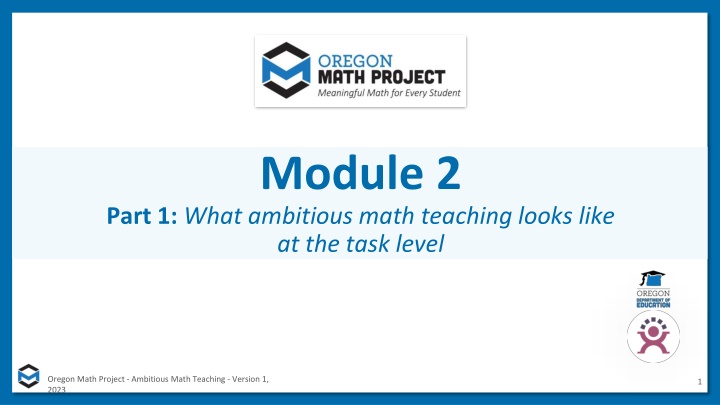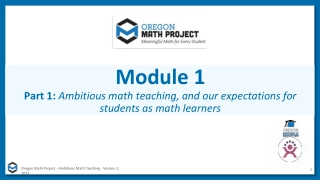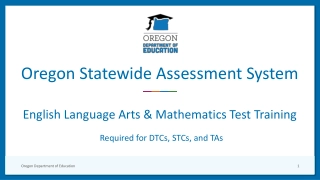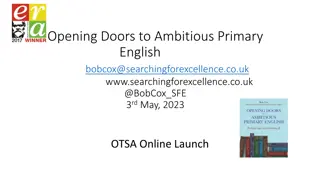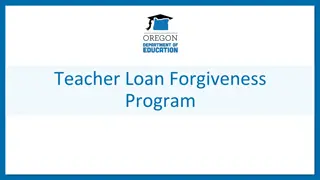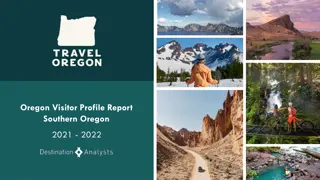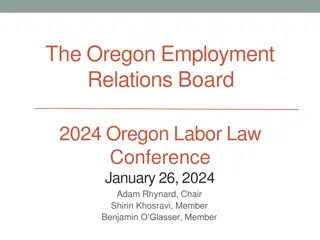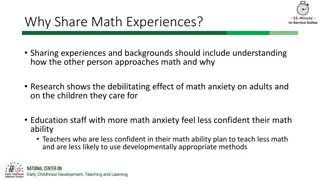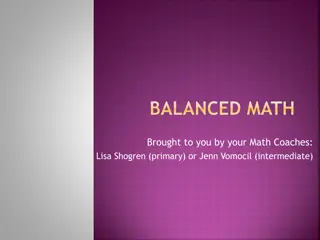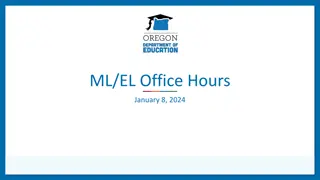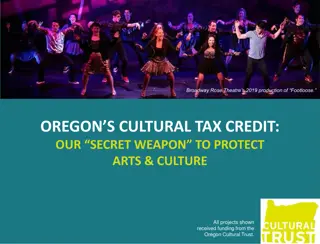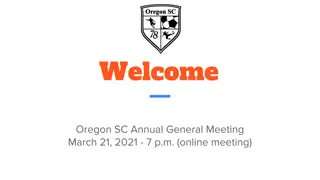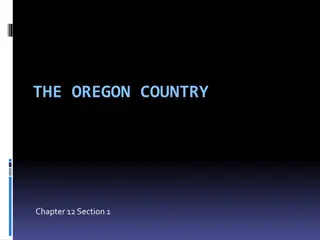Principles and Practices of Ambitious Math Teaching Oregon Math Project
Explore the ambitious math teaching principles and practices outlined in the Oregon Math Project, focusing on sustaining ambitious math teaching through effective planning, teaching, and assessment strategies. Discover how to value and build on students' mathematical strengths to promote equitable outcomes in mathematics education.
Download Presentation

Please find below an Image/Link to download the presentation.
The content on the website is provided AS IS for your information and personal use only. It may not be sold, licensed, or shared on other websites without obtaining consent from the author.If you encounter any issues during the download, it is possible that the publisher has removed the file from their server.
You are allowed to download the files provided on this website for personal or commercial use, subject to the condition that they are used lawfully. All files are the property of their respective owners.
The content on the website is provided AS IS for your information and personal use only. It may not be sold, licensed, or shared on other websites without obtaining consent from the author.
E N D
Presentation Transcript
Module 2 Part 1: What ambitious math teaching looks like at the task level Oregon Math Project - Ambitious Math Teaching - Version 1, 2023 1
Essential Questions of the Modules What is ambitious math teaching? Why is a 2 + 1 model important for equitable outcomes in mathematics? Module 1: Foundations of High School Math Instruction What does ambitious math teaching look like at the unit, lesson, and task levels? How do we value and build on the mathematical strengths of students who are often excluded by schooling? Module 2: Principles and Practices of Ambitious Math Teaching What planning, teaching, and assessment practices can be used to sustain ambitious math teaching? Module 3: Principles and Practices of Sustainability Oregon Math Project - Ambitious Math Teaching - Version 1, 2023 5
Four Cornerstones: Oregon Math Project & Oregon Educational Goals (ORS 329.015) Provide students with the skills necessary to pursue learning throughout their lives in an ever-changing world. (ORS 329.015(2)(a)) Provide an environment that motivates students to have experience in applying knowledge and skills and demonstrating achievement. (ORS 329.015(2)(b)) Equip students with the academic and career skills and information necessary to pursue the future of their choice. (ORS 329.015(2)(a)) Provide an environment that motivates students to pursue serious scholarship. (ORS 329.015(2)(b)) Oregon Math Project - Ambitious Math Teaching - Version 1, 2023 6
Across the modules we will have opportunities to Set and maintain norms: These activities support participants to establish norms that will guide participation in sessions. Do math together: These activities engage participants in a mathematics task. Study teaching: These activities involve analysis of video, vignettes, live teaching, or instructional tools. Connect to research: These activities involve unpacking and understanding the research in mathematics education underpinning focal ideas and concepts. Plan for action: These activities involve making links between session content and our own practice and contexts. Oregon Math Project - Ambitious Math Teaching - Version 1, 2023 7
Reconnecting Share a new, since we last met personal piece of information to help us reconnect with you. Share a new, since we last met professional piece of information in to help us reconnect and get to know you professionally as an educator. OR Oregon Math Project - Ambitious Math Teaching - Version 1, 2023 8
Reconnecting to our thinking from the previous sessions Oregon Math Project - Ambitious Math Teaching - Version 1, 2023 9
Session 7 The focus of this session is to deepen our understandings related to reasoning and sensemaking. Ambitious math instruction at the task level: Ensuring opportunities for students reasoning and sensemaking Agenda for this session: 1. Setting and maintaining norms: Reconnect with and revise our norms for interacting together 2. Connecting to research: Defining reasoning and sensemaking 3. Doing math together: Reasoning and sensemaking using the Bike and Truck Task 4. Studying teaching: Analyzing opportunities for reasoning and sensemaking in Ms. Shackelford s lesson 5. Planning for action: Adapting a task to ensure opportunities for students reasoning and sensemaking Time estimate:2 hours M2 P1 Table of Contents 10 Oregon Math Project - Ambitious Math Teaching - Version 1, 2023
Setting and maintaining norms Reconnect with and revise our norms for interacting together Oregon Math Project - Ambitious Math Teaching - Version 1, 2023 11
Revisiting norms Rights of a Learner You have the right to: Be confused Make mistakes Say what makes sense to you Share unfinished or rough draft thinking and not be judged [Insert your group norms] (Kalinec-Craig, C. A., 2017) Oregon Math Project - Ambitious Math Teaching - Version 1, 2023 13
Small Group Activity Directions: Use the workspace slide to reflect on, reconnect with, and revise our norms. Oregon Math Project - Ambitious Math Teaching - Version 1, 2023 14
Preview of Workspace Slide Team names: our DRAFT norms What do you want to add, delete, or revise in our norms to maximize your learning? What is your reasoning? 1. Provide space and permission to make mistakes in mathematical thinking and reasoning. Challenge each other with kindness and give time for everyone s needs as well as tech needs. Balance the talking time, center students who are often excluded from rich mathematics in our conversations. Listen completely to each other and not assume. Withhold judgement while listening when sharing rough draft thinking. Keep conversations focused. Stay Curious. Ask Questions Always approach math through an equity lens & honor initial private think time and the ability to ask for more if needed. Be open-minded about the process. Be transparent! No spoilers - let others get to an answer/conclusion. Seek to understand & be open to different ideas and approaches. 10. Avoid interrupting others & assume best intentions 2. 3. How could our norms possibly not result in equitable outcomes? 4. 5. What understandings and skills would we need in the norms to position each and every student as competent? 6. 7. 8. 9. Oregon Math Project - Ambitious Math Teaching - Version 1, 2023 15
Connecting to research: Defining reasoning and sensemaking Oregon Math Project - Ambitious Math Teaching - Version 1, 2023 16
Why was reasoning added to the title of every domain of the math content standards? (ODE, 2022) Oregon Math Project - Ambitious Math Teaching - Version 1, 2023 18
Reasoning and sensemaking Reasoning and sensemaking are the cornerstones of mathematics. Restructuring the high school mathematics program around them enhances students development of both the content and process knowledge they need to be successful in their continuing study of mathematics and in their lives. (NCTM, 2009) Oregon Math Project - Ambitious Math Teaching - Version 1, 2023 19
What impact does reasoning have on the cognitive demand of a task? (ODE, 2022) Oregon Math Project - Ambitious Math Teaching - Version 1, 2023 20
Read the two classroom scenarios. - What do you notice? - What do you wonder? Scenarios adapted from: (NCTM, 2009) 21 Oregon Math Project - Ambitious Math Teaching - Version 1, 2023
Small Group Activity Directions: Use the workspace slide to re-envision a classroom scenario with a focus on reasoning and sensemaking. Oregon Math Project - Ambitious Math Teaching - Version 1, 2023 22
Preview of Workspace Slide Team names: Consider the following algebra math standard and the task off to the right. HS.AFN.A.3 Calculate and interpret the average rate of change of a function over a specified interval. Feet Scenario without explicit focus on reasoning and sensemaking: The teacher asks, do we have a formula for calculating the rate of change? Students respond with the slope formula. So what is the average rate of change between 1 second and 1.2 seconds? The teacher asks for an answer and what it means. The students respond with a slope calculation using the formula and it means that it is the rise over the run. Seconds The height of a thrown horseshoe depends on the time that has elapsed since its release, as shown in the graph. Re-envision this scenario with an explicit focus on reasoning and sensemaking. What is the average rate of change between 1 second and 1.2 seconds? (Martin & Robinson, 2011) Oregon Math Project - Ambitious Math Teaching - Version 1, 2023 23
Generalizing to practice What is the same and different across our examples? What are generalizable ideas that we can use to always keep reasoning and sensemaking at the center of our lessons? Oregon Math Project - Ambitious Math Teaching - Version 1, 2023 24
Math Quote A high school mathematics program based on reasoning and sensemaking will prepare students for citizenship, for the workplace, and for further study. (NCTM, 2009) Oregon Math Project - Ambitious Math Teaching - Version 1, 2023 25
What do we mean by reasoning and sensemaking? Reasoning: The process of drawing conclusions on the basis of evidence or stated assumptions Sensemaking: Developing understanding of a situation, context, or concept by connecting it with existing knowledge (NCTM, 2009, pp. 4-5) Oregon Math Project - Ambitious Math Teaching - Version 1, 2023 26
Small Group Activity Directions: Use the workspace to record insights about reasoning and sensemaking. Oregon Math Project - Ambitious Math Teaching - Version 1, 2023 27
Preview of Workspace Slide Team names: Read two of the questions and responses in the FAQ document from NCTM s Focus in High School Mathematics: Reasoning and Sensemaking. Record an insight here: Oregon Math Project - Ambitious Math Teaching - Version 1, 2023 28
Students can learn mathematical reasoning! Mathematical reasoning is something that students can learn to do (p. 33) Two important benefits of reasoning: 1. it aids students mathematical understanding and ability to use concepts and procedures in meaningful ways, and 2. it helps students reconstruct faded knowledge that is knowledge that is forgotten by students but can be restored through reasoning with the current content. (Ball & Bass, 2003) 29 Oregon Math Project - Ambitious Math Teaching - Version 1, 2023
Debrief: Principles of ambitious mathematics teaching Which of these ideas are you thinking about in light of our work? What questions do you have? Ambitious teaching: Engages students in making sense of mathematical concepts Centers students thinking and reasoning through discourse Views students as capable of using their understandings and assets to solve authentic problems Values students thinking, including emergent understanding and errors Attends to student thinking in an equitable and responsive manner Ambitious teaching is teaching that deliberately aims for all students across ethnic, racial, class, and gender categories not only to acquire, but also to understand and use knowledge, and to use it to solve authentic problems. (Lampert & Graziani, 2009, p. 492) (Anthony et al., 2015) Oregon Math Project - Ambitious Math Teaching - Version 1, 2023 30
Doing math together: Reasoning and sensemaking using the Bike and Truck Task Oregon Math Project - Ambitious Math Teaching - Version 1, 2023 31
The Bike and Truck Task: Goals for us as math learners: Mathematical goal: Deepen our understanding of how context is important for interpreting key features of a graph portraying the relationship between time and distance Equity goal: Elicit diverse perspectives by continually pressing for reasoning and sense making Goals for us as teachers: Equity goal: Expand our vision for what mathematical reasoning and sensemaking look like and sound like by recognizing the power of students sharing rough draft ideas Pedagogical goal: Develop understanding of what instructional moves that elicit reasoning and sensemaking look like and sound like Oregon Math Project - Ambitious Math Teaching - Version 1, 2023 33
Rich mathematical student discourse The act of JUSTIFYING may produce an argument that is not mathematically valid, OR it may produce an argument that is a mathematical justification because it is mathematically valid. The act of GENERALIZING may produce conjectures that are not yet justified, OR it may produce mathematical generalizations for which a mathematical justification can be provided. How are justifying and generalizing related to reasoning and sensemaking? Oregon Math Project - Ambitious Math Teaching - Version 1, 2023 34
Why student discourse? Student Benefit: Increasing the level of discourse in groups produces greater student learning; explaining to other students is positively related to achievement outcomes even when controlling for prior achievement. However, just getting students to talk was not enough: what they talked about mattered (NCTM Research Journal, 2007). Teacher Benefit: A powerful way to measure the impact of your implementation of the research on math teaching and learning is to analyze Student Mathematical Discourse. Oregon Math Project - Ambitious Math Teaching - Version 1, 2023 35
Bike and Truck Task (NCTM, 2014) Distance from start of road (in feet) What do you notice? What do you wonder? Time (in seconds) This slide was adapted from: (Smith, 2014) Oregon Math Project - Ambitious Math Teaching - Version 1, 2023 36
Bike and Truck Task (NCTM, 2014) A bicycle and a truck are moving along the same road in the same direction. Distance from start of road (in feet) Discussion questions posed by teacher: 1. Between what two seconds did the truck drive the fastest? How do you know? Who was moving faster on the interval from 260 feet to 300 feet? 2. Time (in seconds) This slide was adapted from: (Smith, 2014) 37 Oregon Math Project - Ambitious Math Teaching - Version 1, 2023
Small Group Activity Directions: Use the workspace slide to make sense of and draft a solution to the Bike and Truck Task. Oregon Math Project - Ambitious Math Teaching - Version 1, 2023 38
Preview of Workspace Slide Team names: 1. Between what two seconds did the truck drive the fastest? How do you know? Distance from start of road (in 1. Who was moving faster on the interval from 260 ft to 300 ft? How do you know? feet) Time (in seconds) This slide was adapted from: (Smith, 2014) Oregon Math Project - Ambitious Math Teaching - Version 1, 2023 39
Debriefing the Bike and Truck Task: Goals for us as math learners: Mathematical goal: Deepen our understanding of how context is important for interpreting key features of a graph portraying the relationship between time and distance Equity goal: Elicit diverse perspectives by continually pressing for reasoning and sense making 1. How did you see me working on each of these goals during the lesson? 2. What moves was I making as a teacher of mathematics? 3. What moves could have been made to support our work on these goals even more? Oregon Math Project - Ambitious Math Teaching - Version 1, 2023 40
Debriefing the Bike and Truck Task: Goals for us as teachers: Equity goal: Expand our vision for what mathematical reasoning looks like and sounds like by recognizing the power of students sharing rough draft ideas Pedagogical goal: Develop understanding of what instructional moves that elicit reasoning and sensemaking look like and sound like 1. What new ideas do you have about what reasoning and sensemaking look like and sounds like? 2. What questions do you have about supporting students reasoning and sensemaking? Oregon Math Project - Ambitious Math Teaching - Version 1, 2023 41
Debrief: Practices of ambitious mathematics teaching Which of these 8 practices did you notice? What others could have been highlighted? In what ways? 1. Establish mathematical goals to focus learning 2. Implement tasks that promote reasoning and problem solving 3. Use and connect mathematical representations 4. Facilitate meaningful mathematical discourse 5. Pose purposeful questions 6. Build on procedural fluency from conceptual understanding 7. Support productive struggle in learning mathematics 8. Elicit and use evidence of student thinking v (NCTM, 2014) Oregon Math Project - Ambitious Math Teaching - Version 1, 2023 42
Debrief: Habits, routines, and actions Which of these habits did you notice? What others could have been highlighted? In what ways? Habits of Mind: Things we do as individual mathematicians when solving problems. v Habits of Interaction: Things that we do when working with others to make sense of the math. 4 3 (TDG, 2020) Oregon Math Project - Ambitious Math Teaching - Version 1, 2023
Studying teaching: Analyzing opportunities for reasoning and sensemaking in Ms. Shackelford s lesson Oregon Math Project - Ambitious Math Teaching - Version 1, 2023 44
Rich mathematical student discourse The act of JUSTIFYING may produce an argument that is not mathematically valid, OR it may produce an argument that is a mathematical justification because it is mathematically valid. The act of GENERALIZING may produce conjectures that are not yet justified, OR it may produce mathematical generalizations for which a mathematical justification can be provided. How are justifying and generalizing related to reasoning and sensemaking? Oregon Math Project - Ambitious Math Teaching - Version 1, 2023 46
Justify JUSTIFY To justify why a solution or mathematical statement makes sense, or is correct/true or incorrect or untrue, students create a logical argument by using: o math structures (definitions, properties, meanings), o connections between math structures and mathematical representations, o previously established generalizations, and/or o a counterexample to invalidate a claim The act of justifying may produce an argument that is not mathematically valid, or it may produce a mathematical justification because the argument is mathematically valid. The argument may not be complete but is a start. When working on a problem/task or listening to others' math ideas, students persevere and seek more by: o seeking increasingly robust justifications o not settling for right answers without understanding It is important for students to use justifications about solutions to specific problems as context for generating conjectures and justifications about the general case. This Habit uses math to "argue why" rather than to "verify that," meaning it is not checking an answer or describing a procedure. Oregon Math Project - Ambitious Math Teaching - Version 1, 2023 47
Generalize GENERALIZE When students generalize, they: GENERATE CONJECTURES about the general case (i.e., what is always, sometimes, or never true) by reasoning with: o representations o connections o contradictions (what is NOT true) o regularity in repeated reasoning and/or other patterns o structures (definitions, properties, meanings) o their justifications of solutions to specific problems Note: When students justify why their own and/or someone else's conjecture is sometimes, always, or never valid, this habit would co- occur with the Justify habit. Oregon Math Project - Ambitious Math Teaching - Version 1, 2023 48
Shalunda Shackelfords mathematics learning goals Students will understand that: The language of change and rate of change (increasing, decreasing, constant, relative maximum or minimum) can be used to describe how two quantities vary together over a range of possible values. Context is important for interpreting key features of a graph portraying the relationship between time and distance. The average rate of change is the ratio of the change in the dependent variable to the change in the independent variable for a specified interval in the domain. This slide was adapted from: (Smith, 2014) 49 Oregon Math Project - Ambitious Math Teaching - Version 1, 2023
Considerations as we engage with teachers practice Norms for reflecting on excerpts of teaching: Useful sentence stems for reflecting on excerpts of teaching: Approach artifacts of teaching with gratitude: This educator has shared their work to support our learning. Assume that there are many things we do not know about students, classroom, and the shared history of the teacher and students Assume good intent on the part of the teacher Keep focused on what the students are doing and how they are working on the content Use your noticing/wonderings to raise questions about your own students and your own classroom. I noticed when the teacher _____ students _____. I am curious about why the teacher/students ______. What reasons might they have? Oregon Math Project - Ambitious Math Teaching - Version 1, 2023 50
Characterizing students mathematical discourse 1. Identify at least one example of when students are justifying and one example of when students are generalizing. How are the students using the other Habits to justify and generalize? 2. What does the teacher do to support students engagement in and understanding of mathematics, and the effective mathematics teaching practices of facilitating meaningful mathematical discourse and posing purposeful questions? Be prepared to share: Specific line numbers from the transcript Brief justification for your thinking Oregon Math Project - Ambitious Math Teaching - Version 1, 2023 51
Shalunda Shackelfords classroom Embed Video Here Oregon Math Project - Ambitious Math Teaching - Version 1, 2023 52
Small Group Activity Directions: Use the workspace slide to record students justifications and generalizations, and the teachers moves. Oregon Math Project - Ambitious Math Teaching - Version 1, 2023 53
Preview of Workspace Slide Team names: Use specific line numbers from the transcript, and briefly justify your thinking. Students justifications and generalizations Teachers moves Oregon Math Project - Ambitious Math Teaching - Version 1, 2023 54
Preview of Workspace Slide Bike and Truck Transcript Student Names Line 3 & 6 Valery Line 26 Chelsea Line 10 & 13 Mykel Line 30, 34, 37 Tony Line 16 & 19 Lauren Line 44, 46, 55, 58 Stephanie Line 21, 40, 52 Ne Kail Line 59, 61 Tamela Oregon Math Project - Ambitious Math Teaching - Version 1, 2023 55
Implementing ambitious math teaching Ambitious math teaching enables students to develop positive mathematical identities. Mathematical identity is the way in which people think of themselves in relation to mathematics: Having a positive mathematical identity means that people feel empowered by mathematics and as doers of mathematics, see the multiple purposes for learning mathematics, appreciate why mathematics is important in their lives, and come to believe that they can succeed in mathematics. The ways in which students experience mathematics have a significant impact on the way in which they identify themselves as doers of mathematics. (NCTM, 2020) Oregon Math Project - Ambitious Math Teaching - Version 1, 2023 56
Small Group Activity Directions: Use the workspace slide to debrief the Bike and Truck task, identifying practices we saw related to each of the five principles of ambitious math teaching. Oregon Math Project - Ambitious Math Teaching - Version 1, 2023 57
